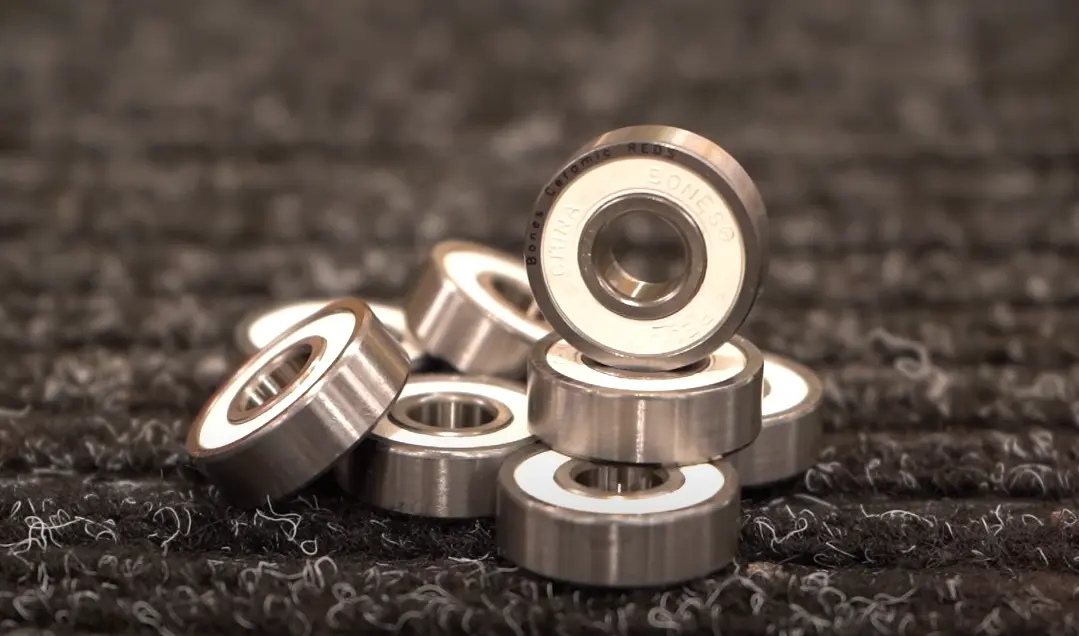I recently hit the market for new bearings and find myself drawn to the reputable Bones Swiss bearings. However, another product that catches my attention is the renowned Bones Swiss Ceramics. From what I’ve read, ceramics are much smoother, long-lasting, and don’t need oil/grease which seems great, but the price tag is so much larger.
In fact, ceramic bearings can be brittle so if you jump a lot you might break them.
They do need oil (better grease), unless you want very noisy bearings (just as dry normal ones)
And worse of all, they’re a lot more expensive without any advantage. Ceramic bearings are for machines that go at ludicrous fast speeds.
Ceramic bearings don’t withstand stress as well as other materials. If you do jumps, stomps, or footwork that will place more stress on that part of your skate – you risk damage at a much lower threshold than steel.
Although I had low expectations for ceramic bearings, I was still let down by their performance.
What are Ceramic Skateboard Bearings?
Skateboarding has always been my passion, and as I strive to enhance my riding experience, I found myself delving into the world of ceramic skateboard bearings.
Ceramic skateboard bearings are not your typical bearings. They feature ceramic balls, often made from materials like silicon nitride, that replace the traditional steel balls found in standard bearings.
One of the standout features of ceramic bearings is their ability to minimise friction. As I swapped out my old steel bearings for ceramic ones, I noticed an immediate difference in how effortlessly my skateboard glided along the pavement.
The reduced friction meant less effort required to maintain speed, allowing me to ride longer distances with ease. It was like experiencing a newfound sense of freedom and efficiency.
Do Ceramic Skateboard Bearings Provide a Speed Advantage?
It’s worth mentioning that the overall speed potential of a skateboard is influenced by various factors, including the rider’s skill, terrain, skateboard setup, and other components such as wheels and trucks.
While ceramic bearings can offer a speed advantage, their impact on overall speed may be more apparent in certain conditions or for experienced riders who can fully harness their benefits.
However, it’s essential to approach the concept of speed with realistic expectations. While ceramic bearings can provide improvements in speed and performance, they won’t magically transform a novice rider into a high-speed expert.
Skateboarding still requires practice, technique, and control to fully maximise the potential speed gains offered by the bearing components.
Some Major Points About Ceramic Bearings:
Ceramic Balls: Ceramic bearing can range from around 30% to 60%, depending on the specific design and desired performance characteristics.
Bearing Races: Around 30% to 60%, again depending on the design and desired performance.
Cage or Retainer: Cage material in a ceramic bearing is relatively smaller, usually around 5% to 10%.
Lubrication: less than 5%, but it plays a crucial role in reducing friction and ensuring optimal performance.
Do Ceramic Bearings Offer Waterproof Protection?
No, ceramic bearings do not offer waterproof protection. While ceramic materials themselves are generally resistant to corrosion and rust, the overall waterproofness of a bearing depends on its construction and sealing mechanisms.
Unveiling the Truth: How Can You Determine the Lifespan of Ceramic Skateboard Bearings?
While it’s challenging to provide an exact numerical range for the lifespan of ceramic skateboard bearings, I can offer a rough estimate based on general observations and experiences of skateboarders. Please note that these figures are approximate and can vary depending on individual factors:
Light usage:
If you skate occasionally or engage in low-impact activities, ceramic skateboard bearings can last anywhere from 6 months to 2 years.
Moderate usage:
For regular skateboarding sessions, including casual cruising and moderate tricks, ceramic bearings typically last between 3 months to 1 year.
Heavy usage:
Intense skateboarding activities, such as aggressive street skating, frequent tricks, and participation in skate competitions, may result in shorter lifespans. In such cases, ceramic skateboard bearings may last anywhere from 1 to 6 months.
Are ceramic bearings a practical choice for enhancing longboard performance?
Yes, I highly recommend Bones brand swiss ceramic bearings that are specifically engineered for optimal performance in longboarding. They’re the absolute best skate/longboard bearings on the market or at least one of the best. They’re expensive ( $160) but you shouldn’t need to replace them for a long time given that they’re taken care of. DO NOT leave the board outside. The rain warps the wooden deck and can rust your hardware, trucks and bearings.
I often lubricate these bearings with WD-40 or another household lubricant but NEVER water.I tested it this way and i flip my board over, wrap your fingers around a wheel and spin it as hard as you can. It should continue to spin for another 30–45 seconds at least. If it doesn’t, it needs lubricant.
When to purchase ceramic bearings?
After conducting multiple interviews with local longboarders,my team and I concluded that there are certain features where purchasing ceramic bearings can be advantageous:
The feedback from local longboarders suggests that ceramic bearings are advantageous due to their performance, durability, speed, and resistance to moisture.
However, It’s worth noting that ceramic bearings can be more expensive than steel bearings.The higher cost may be a determining factor for some riders when making their purchasing decisions.
Reason to Avoid:
While acknowledging the advantages of ceramic bearings, some longboarders express concerns about the higher cost associated with purchasing them. Affordability remains a factor for consideration, especially for riders on a tighter budget.
Recommendations From Local Skaters:
Local longboard communities highly recommend Bones brand swiss ceramic bearings that are specifically engineered for optimal performance in longboarding. They’re the absolute best skate/longboard bearings on the market or at least one of the best. They’re expensive ($160) but you shouldn’t need to replace them for a long time.
Closing Remarks:
As we’ve explored, ceramic skateboard bearings come with unique attributes that both attract and deter skaters. Their reduced friction, durability, and resistance to rust can offer a smoother, more efficient ride, especially for longboarders who appreciate enhanced cruising performance. However, the hype around ceramics does sometimes gloss over their real limitations—especially regarding brittleness under stress, need for lubrication, and a significantly higher price tag.
While ceramic bearings may be ideal for those who prioritize longevity and smoother rolling at higher speeds, riders should consider their own style, budget, and maintenance habits before making the investment. For skaters seeking robust, all-around durability, high-quality steel bearings may offer a better balance of performance and resilience, especially for tricks and high-impact skateboarding.
Ultimately, while ceramic bearings have their advantages, they aren’t a magic upgrade. Knowing your riding needs and expectations will be your best guide in choosing the right bearings to keep you rolling smoothly.

